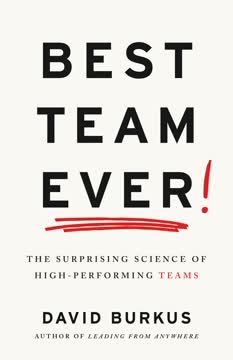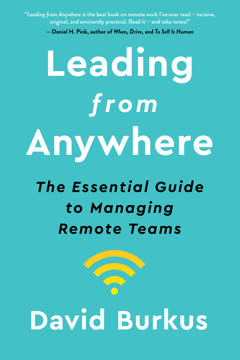Key Takeaways
1. Team Culture, Not Talent, Drives Performance
Talent doesn’t make the team. The team makes the talent.
Culture over composition. Decades of research and real-world examples, like the "Team Reject" USA Curling team, show that the collective culture of a team is a far greater predictor of success than the individual skills or resumes of its members. Even highly talented individuals will underperform in a broken team culture, while a strong culture can elevate average talent to extraordinary results. This principle is universal across sports, business, and other collaborative environments.
The Google revelation. Project Aristotle at Google, a massive study of 180 teams, initially sought an algorithmic formula for the perfect team based on member attributes. They found no correlation between individual talent or composition and team effectiveness. The key differentiator was team norms – how members interacted, shared, and collaborated.
Culture's dominant influence. As work increasingly relies on teams, team culture becomes the primary driver of individual experience and collective outcomes. A positive culture energizes and inspires, while a negative one drains and demotivates. Building a high-performing team means cultivating the right culture, not just recruiting the "best" people.
2. Common Understanding: Clarity & Empathy
Common understanding happens when team members understand the team’s expertise, assigned tasks, context, and preferences.
Foundation for collaboration. High-performing teams build a shared understanding that goes beyond just knowing tasks. It involves knowing who knows what, how individuals prefer to work, and how their roles fit into the larger picture. This collective intelligence allows teams to coordinate efforts efficiently and anticipate each other's actions.
Clarity and empathy combined. This element has two key components: clarity of roles, responsibilities, and processes, and empathy for the individual perspectives, emotions, and working styles of teammates. Both are necessary for optimal performance. Without common understanding, teams struggle with doubt, decreased motivation, and coordination breakdowns.
Learning from space. Astronaut Chris Hadfield's successful command of Expedition 35, with a multinational crew, highlights the importance of common understanding. Despite language and cultural differences, Hadfield prioritized preparation focused not just on technical procedures (clarity) but also on understanding each other's preferences, families, and potential emotional responses (empathy). This preparation enabled them to navigate unexpected crises smoothly.
3. Clarity: Define Roles and Expectations
When team members know what’s expected of them, and they trust others to do it, they perform at a higher level.
Precision in practice. Pal's Sudden Service, a fast-food chain known for near-perfect orders delivered in seconds, exemplifies extreme clarity. Their rigorous training (120+ hours for new hires, 800 for managers) ensures every employee understands every process at every station. This level of role clarity and procedural precision minimizes errors and maximizes speed.
Clarity enhances collaboration. Counterintuitively, clear individual roles don't hinder collaboration; they improve it. When team members are confident in their own responsibilities and trust others to handle theirs, they waste less energy negotiating turf and more time focusing on interdependent tasks. Research shows clearly defined roles lead to smoother collaboration.
Tools for clarity: Leaders can foster clarity through various practices:
- Hold Huddles: Brief check-ins (daily or weekly) on completed tasks, next focus, and blockers.
- Communicate in Bursts: Balance focused solo work with concentrated periods of team communication.
- Draft Team Charters: Collaboratively define norms for communication, decision-making, and asking for help.
- Make Priorities Clear: Define commander's intent or top priorities to guide effort and empower adaptation.
- Set If-Then Plans: Pre-define responses to potential situations ("If X happens, then we will do Y") to reduce confusion during chaos.
4. Empathy: Understand Each Other as Humans
When teams understand not just their roles and responsibilities, but also the emotions and desires of their teammates, they operate at a higher level.
Beyond the job description. Empathy allows team members to understand each other's perspectives, strengths, weaknesses, fears, and opinions. This deep understanding enables teams to play "chess, not checkers," leveraging the unique capabilities of each individual rather than treating everyone as interchangeable pieces. It's clarity of person, not just clarity of roles.
Social sensitivity matters. Research, like Anita Williams Wooley's collective intelligence studies, shows that a team's social sensitivity – its ability to perceive and respond to teammates' emotions – is a strong predictor of performance. Teams with high social sensitivity have more balanced conversations and are better able to respond to subtle cues, leading to higher collective intelligence.
Cultivating connection: Empathy often develops through non-work interactions and deliberate efforts to understand the whole person.
- Write Teammate Manuals: Individuals share preferences, strengths, and needs ("User's manual for me").
- Find Free Time: Create opportunities for informal socialization (meals, coffee chats) to build bonds and uncover uncommon commonalities.
- Break the Ice: Use structured icebreakers (Triple H, Energy Check, Defining Moment, Three Snaps) to encourage vulnerability and self-disclosure.
- Share Gratitude: Regularly express appreciation for teammates' contributions, reinforcing their value and fostering a willingness to help.
5. Psychological Safety: Trust & Respect
Psychological safety actually drives performance.
Safety to be vulnerable. Psychological safety is the shared belief that the team is safe for interpersonal risk-taking. It's feeling comfortable being yourself, expressing ideas, asking questions, admitting mistakes, and disagreeing respectfully without fear of embarrassment or punishment. This safety is foundational for learning, innovation, and high performance.
Discovery in healthcare. Harvard professor Amy Edmondson coined the term in organizational research after studying hospital nursing teams. She found that teams with "better" leaders documented more errors. This wasn't worse performance, but a safer environment where nurses felt comfortable admitting mistakes, allowing the team to learn and prevent future errors.
Diversity needs safety. While diversity is valuable, without psychological safety, it can lead to increased conflict and decreased performance. When teams feel safe, diverse perspectives are welcomed and leveraged for better outcomes. Psychological safety reduces fear, which can shut down cognitive function, thus enhancing clarity of thought and problem-solving.
6. Trust: Signal Vulnerability to Build Connection
Trust on a team acts as a social lubricant.
Reducing social friction. When team members trust each other, they are more willing to share ideas, offer help, and be open about challenges. This free flow of information and support reduces friction and makes collaboration easier and more enjoyable. Without trust, people hold back, diminishing collective brilliance.
Trust is reciprocated. Research by Paul Zak highlights that trust isn't just given or earned; it's reciprocated, driven by the brain chemical oxytocin. When someone feels trusted, they are more likely to act in a trustworthy manner. This creates a virtuous cycle where initial acts of vulnerability or trust from one person (often the leader) encourage others to respond in kind.
Building the cycle: Leaders can initiate the trust cycle:
- Signal Vulnerability: Leaders admit mistakes or limitations ("I don't know," "I was overwhelmed") to show fallibility and interdependence.
- Celebrate Failures: Reframe mistakes as "learning moments" and discuss lessons openly, removing the fear of punishment.
- Share Privileged Intel: Share relevant information (budgets, customer data) to signal trust in the team.
- Create Rituals: Shared experiences, even simple ones, build belonging and make people feel safe as insiders.
- Hold After-Action Reviews: Debrief projects to identify lessons learned, not assign blame, fostering open discussion of successes and failures.
7. Respect: Value Every Voice and Perspective
Employees who got respect from their leaders reported 89 percent higher satisfaction with work and 56 percent better well-being and overall health.
Respect fuels engagement. Feeling respected is a powerful driver of employee engagement, satisfaction, focus, and overall well-being. Conversely, disrespect leads to decreased effort, lower quality work, reduced performance, and higher turnover, especially among high performers. Respect is arguably the single most impactful leadership behavior.
Respect is learned. Christine Porath's research indicates that disrespectful behavior is often modeled from leaders or peers. This means respect is a learned behavior that can be taught and cultivated within a team or organization. Leaders play a critical role in modeling and enforcing respectful interactions.
Cultivating respect: Leaders and teams can build a culture of respect:
- Model Active Listening: Use techniques like RASA (Receive, Appreciate, Summarize, Ask) and phrases like "Tell me more" to show you value others' input.
- Recognize, and Share Credit: Publicly acknowledge contributions and share credit for successes to show appreciation for individual and team efforts.
- Treat Conflict as Collaboration: Approach disagreements as opportunities to explore different perspectives and improve ideas, rather than personal battles. Question assumptions respectfully.
- Call for Candor: Actively solicit dissenting opinions, especially when consensus is too quick, creating space for unheard voices.
- Amplify Unheard Voices: Ensure everyone has a chance to speak and be heard, preventing dominant personalities from silencing others.
8. Prosocial Purpose: Meaning & Impact
We all want to do work that matters.
Beyond the mission statement. While organizational mission is important, true inspiration comes from knowing that your work makes a meaningful contribution to the lives of others. Prosocial purpose is the desire to protect and promote the well-being of others, and it is a powerful motivator for individuals and teams.
Purpose is personal. People are most motivated when they can see the tangible impact of their work on specific individuals. Generic statements about growth or shareholder value are less inspiring than knowing "Who is served by the work that we do?" This personal connection to beneficiaries drives engagement and effort.
Reframing the mundane. Companies like KPMG and Kaiser Permanente successfully boosted morale and performance by helping employees in seemingly "boring" or "support" roles see the prosocial impact of their work. KPMG's "10,000 Stories Challenge" showed accountants how their audits protected families' savings, while Kaiser Permanente's "I Saved A Life" program empowered support staff to see their role in preventing life-threatening illnesses.
9. Meaning: See Your Contribution to the Whole
Contribution is the core of meaningful work.
Connecting tasks to value. People find work meaningful when they understand how their specific tasks contribute to the larger goals of the team and organization, and how that work creates value for others. Jobs that feel like random, disconnected tasks with no clear outcome are inherently demotivating.
The Sisyphus effect. Behavioral economics research, like Dan Ariely's Lego study, demonstrates how quickly motivation plummets when people are reminded that their work doesn't matter or has no lasting contribution. Conversely, even small reminders of contribution can significantly boost effort and engagement.
Highlighting significance: Leaders can help teams see the meaning in their work:
- Make Metrics Meaningful: Connect performance numbers (sales, efficiency) to their real-world impact (e.g., plastic kept out of the ocean).
- Give the "It's A Wonderful Life" Test: Imagine the void left if the team or organization didn't exist to highlight their unique contribution.
- Create Team Symbols: Develop visual or physical symbols that represent the team's mission and contribution.
- Create a Rallying Cry: Craft a short, memorable phrase that encapsulates the team's purpose and impact ("pound the rock," "leave the jersey in a better place").
- Share a Win Every Day: Encourage daily sharing of small successes to reinforce progress and contribution.
10. Impact: Know Who Your Work Serves
Purpose isn’t a why. Purpose is a who.
Seeing the beneficiary. The most powerful way to connect teams to purpose is by showing them the specific people whose lives or work are improved by their efforts. This direct connection to the "who" makes the abstract "why" concrete and emotionally resonant.
Direct exposure works. Studies show that even brief exposure to beneficiaries significantly boosts motivation and performance. Call center workers who met a scholarship recipient raised dramatically more money. Radiologists were more accurate when a patient photo was included with X-rays. Physicians used more hand sanitizer when signs mentioned preventing patient illness.
Bringing beneficiaries closer: Organizations can facilitate this connection:
- Collect Impact Stories: Gather and share specific anecdotes, emails, or testimonials from people served by the team's work.
- Pause for Purpose: Start meetings or tasks with a brief moment to remember the beneficiaries or read an impact story.
- Outsource Inspiration: Invite customers or beneficiaries to speak to the team, or have employees interact directly with those they serve (e.g., Medtronic patients, Best Buy Twelpforce).
- Become the Beneficiary: Have employees experience the product or service from the customer's perspective (e.g., Four Seasons hotel stays, Savannah Bananas "undercover fans").
11. Build All Three: Understanding, Safety, Purpose
Common Understanding, Psychological Safety, and Prosocial Purpose.
Interconnected elements. The three core elements of high-performing teams – Common Understanding, Psychological Safety, and Prosocial Purpose – are not independent but mutually reinforcing. Building clarity and empathy (Understanding) creates a foundation for trust and respect (Safety), which in turn allows teams to openly discuss and connect with their purpose (Purpose).
A virtuous cycle. When teams understand each other and their work (Understanding), they feel safer to be vulnerable and share ideas (Safety). This safety allows them to connect more deeply with the meaning and impact of their work (Purpose), which further motivates them to collaborate and understand each other better, perpetuating the cycle.
Leading the transformation. Leaders are crucial in cultivating these elements. Garry Ridge at The WD-40 Company transformed a stagnant company by focusing on building a "fearless tribe" based on care (Safety), candor (Safety), accountability (Understanding), and responsibility (Understanding). He reframed failures as "learning moments" (Safety) and helped employees see the "hero" impact of their product (Purpose), leading to significant growth and a thriving culture. Building your best team ever requires deliberate focus on all three interconnected elements.
Last updated:
FAQ
1. What’s "Best Team Ever: The Surprising Science of High-Performing Teams" by David Burkus about?
- Focus on Team Culture: The book explores the science and practical strategies behind building high-performing teams, emphasizing that team culture is more important than individual talent.
- Three Core Elements: Burkus identifies three fundamental elements of great team culture: Common Understanding, Psychological Safety, and Prosocial Purpose.
- Real-World Examples: The book uses stories from sports, business, healthcare, and even fast food to illustrate how these elements work in practice.
- Actionable Guidance: It serves as both a training manual and a guide, offering research-backed advice and practical tools for leaders and team members to improve their teams.
2. Why should I read "Best Team Ever" by David Burkus?
- Evidence-Based Insights: The book distills decades of research on team performance into actionable advice, making it valuable for anyone who works in or leads teams.
- Practical Tools: Burkus provides concrete methods, exercises, and rituals that can be implemented immediately to improve team dynamics and results.
- Universal Relevance: Whether you’re in business, sports, healthcare, or any collaborative environment, the principles apply broadly.
- Inspiring Stories: The book is engaging, using compelling stories to make the science memorable and relatable.
3. What are the key takeaways from "Best Team Ever" by David Burkus?
- Team Culture Trumps Talent: The culture of a team has a greater impact on performance than the individual talents of its members.
- Three Essential Elements: High-performing teams share Common Understanding, Psychological Safety, and Prosocial Purpose.
- Practical Implementation: Building these elements requires intentional actions like regular huddles, vulnerability from leaders, and sharing stories of impact.
- Interdependence of Elements: The three elements interact and reinforce each other, creating a virtuous cycle that elevates team performance.
4. What is the "Common Understanding" concept in "Best Team Ever" and how can teams build it?
- Definition: Common Understanding means team members know each other’s expertise, roles, tasks, context, and preferences.
- Benefits: It leads to faster collaboration, easier coordination, and higher collective intelligence.
- How to Build: Teams can use huddles, team charters, clear priorities, and "If-Then" plans to clarify roles and expectations.
- Empathy Matters: Building empathy—understanding teammates as people, not just roles—further enhances common understanding.
5. How does "Psychological Safety" work in David Burkus’s framework, and why is it crucial?
- Definition: Psychological Safety is the shared belief that the team is safe for interpersonal risk-taking, allowing members to express themselves, admit mistakes, and disagree respectfully.
- Impact on Performance: Teams with high psychological safety learn faster, innovate more, and adapt better to challenges.
- Building Blocks: It is built through trust (feeling safe to be authentic) and respect (feeling accepted and valued).
- Leader’s Role: Leaders must model vulnerability, celebrate failures as learning moments, and actively listen to foster psychological safety.
6. What does "Prosocial Purpose" mean in "Best Team Ever," and how does it motivate teams?
- Definition: Prosocial Purpose is when team members know their work makes a meaningful contribution to others, focusing on who benefits from their efforts.
- Motivational Power: Knowing the impact of their work increases engagement, motivation, and retention.
- Making Purpose Personal: Teams are most inspired when they see specific stories or people who benefit from their work, not just abstract mission statements.
- Practical Tactics: Sharing impact stories, pausing for purpose in meetings, and connecting with beneficiaries are ways to reinforce prosocial purpose.
7. What practical methods and rituals does David Burkus recommend for building high-performing teams?
- Regular Huddles: Short, focused meetings to update on progress, priorities, and obstacles.
- Team Charters and Teammate Manuals: Documents that clarify norms, communication preferences, and personal work styles.
- Celebrating Failures and After-Action Reviews: Rituals that turn mistakes into learning opportunities and foster trust.
- Sharing Gratitude and Wins: Regularly expressing appreciation and celebrating small victories to build connection and meaning.
8. How does "Best Team Ever" by David Burkus address the role of leadership in team culture?
- Modeling Behavior: Leaders set the tone by modeling vulnerability, respect, and active listening.
- Empowering Teams: Effective leaders give team members clarity, autonomy, and opportunities to contribute ideas.
- Recognizing and Sharing Credit: Leaders who share credit and amplify unheard voices foster respect and engagement.
- Purpose Communication: Leaders who regularly discuss the team’s purpose and impact drive higher motivation and performance.
9. What are some of the most compelling stories or case studies in "Best Team Ever" and what do they illustrate?
- Team USA Curling ("Team Reject"): Demonstrates that team culture can overcome lack of external validation and lead to Olympic gold.
- Chris Hadfield’s Space Station Crew: Shows the importance of common understanding and empathy in high-stakes, multicultural teams.
- Pal’s Sudden Service: Highlights the power of clarity and rigorous training in achieving near-perfect performance in fast food.
- Savannah Bananas Baseball Team: Illustrates how focusing on impact and fan experience can create extraordinary engagement and results.
10. What are the best quotes from "Best Team Ever" by David Burkus and what do they mean?
- "Talent doesn’t make the team. The team makes the talent." – Emphasizes that team culture shapes individual performance more than innate ability.
- "Great teams play chess, not checkers." – Highlights the need to recognize and leverage individual differences rather than treating everyone the same.
- "Diversity without safety is anarchy." – Warns that diversity only benefits teams when psychological safety is present.
- "Purpose isn’t a why. Purpose is a who." – Reminds teams to focus on the people they serve, not just abstract goals.
11. How do the three elements—Common Understanding, Psychological Safety, and Prosocial Purpose—interact in "Best Team Ever"?
- Mutual Reinforcement: Each element strengthens the others; for example, psychological safety enables deeper common understanding, and shared purpose motivates trust and openness.
- Virtuous Cycle: As teams build one element, it becomes easier to develop the others, leading to exponential improvements in performance and engagement.
- Holistic Approach: High-performing teams don’t focus on just one element; they intentionally cultivate all three for maximum impact.
- Adaptability and Innovation: The interplay of these elements allows teams to attract talent, generate ideas, and take risks that drive success.
12. What are the first steps a leader or team member should take to apply the advice from "Best Team Ever" by David Burkus?
- Assess Current Culture: Reflect on the team’s current levels of clarity, safety, and purpose using the frameworks in the book.
- Start Small: Implement one new ritual or practice, such as daily huddles or sharing gratitude, and build from there.
- Model Desired Behaviors: Leaders and influential team members should go first in showing vulnerability, respect, and purpose-driven communication.
- Iterate and Involve the Team: Regularly review what’s working, involve the team in co-creating norms, and adjust practices to fit the team’s unique context.
Review Summary
Best Team Ever receives mixed reviews, with an average rating of 3.86 out of 5. Readers appreciate the practical insights, engaging stories, and reminders of effective team leadership principles. Many find it helpful for team-building discussions and personal growth. However, some criticize the lack of originality and depth in content. The book is praised for its accessibility and focus on trust, empathy, and respect. While not groundbreaking, it offers valuable perspectives on creating high-performing teams and fostering a sense of community in various settings.
Similar Books
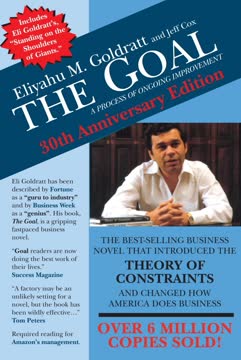

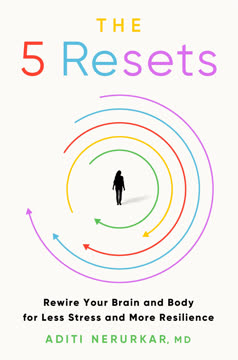
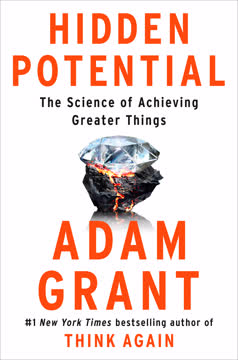




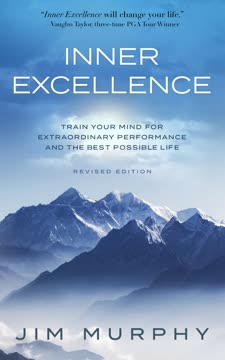

Download PDF
Download EPUB
.epub digital book format is ideal for reading ebooks on phones, tablets, and e-readers.
